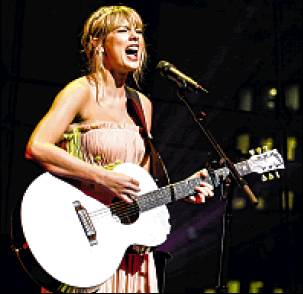music
Album puts ‘folklore’ in spotlight
Local expert weighs in on meaning of, confusion surrounding word
By indiana nasH Staff Writer
SCHENECTADY — Taylor Swift isn’t usually on Ellen McHale’s artist radar. As executive director of New York Folklore on Jay Street, McHale typically works with folklorists and artists from across the state, but she was surprised when she heard about “Folklore,” Swift’s latest album.
“I was intrigued by why Taylor Swift chose that title,” McHale said.
It’s a question many have been asking since Swift announced the album last week. It’s also led many to wonder: What is folklore?
In the album announcement, Swift wrote, “A tale that becomes folklore is one that is passed down and whispered around. Sometimes even sung about. The lines between fantasy and reality blur and boundaries between truth and fiction become almost indiscernible.”
Some national media outlets have published articles defining it. Last week, Refinery29 wrote that folklore is the “traditional customs preserved among a community, like stories, legends, songs, sayings, dances and popular beliefs,” and that it’s “a belief that’s been widely circulated and well-known without any supporting evidence.”
According to McHale, those definitions don’t quite capture the meaning of folklore.
“While often portrayed as ‘inaccuracies,’ or ‘quaint and old-fashioned,’ folklore is much more than that misunderstood characterization,” McHale said, “Although folklore does connect people to their past, the expression of folklore is an integral part of life in the present. Its manifestation is at the center of the idea of culture.”
The album “Folklore” features songs about heartbreak, loss, love and remorse. It’s been hailed for its emotional acuity and rich musical landscape. Though it’s seen as a departure from her previous works, many have praised the storytelling and authenticity, an important concept to folklorists, according to McHale.
“Every group of people that shares a sense of identity shares folklore as part of their identity. It is a way that people comment upon their shared experiences. Folklore during the current COVID-19 pandemic is all around us, and it is easily apparent in the ways that people are responding creatively to their experiences,” McHale said.
Some artists, especially during the American folk music revival of the 1960s, used traditional folklore narratives in their music, including Joan Baez. While traditional folk narratives are not necessarily featured on Swift’s album, McHale believes there could be a link between some of Swift’s songs and traditional Anglo American ballads or English ballads.
“If you look at those, English and Scottish ballads are rife with murder and people being preyed upon, and heartbreak,” McHale said.
McHale has also noticed that the album has created a buzz around the topic, which hasn’t been prompted by a national artist in years. In the past few days, people have been searching for a definition of folklore, and some are coming across organizations such as New York Folklore and the American Folklore Society (AFS), which McHale is involved in as well.
AFS created a webpage called WhatIsFolklore.org because of the album. The page is dedicated to answering that question and providing examples for people. According to McHale, folklorists around the country are discussing the album, and she hopes it draws more people to learning about folklore.
“I ask those who are intrigued with Taylor Swift’s new album ‘Folklore’ to use this moment as a stepping-off place to find out about folklore in your communities. Folklorists are working throughout New York state — in arts organizations, museums, universities and libraries — to draw attention to the diverse ways that folklore is apparent in our communities, and to support folklore and folk arts at the grassroots,” McHale said.

